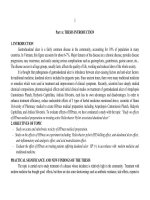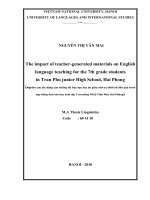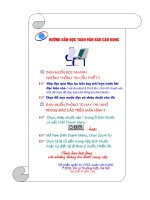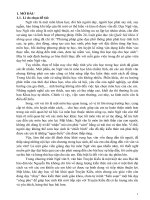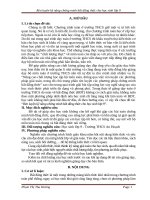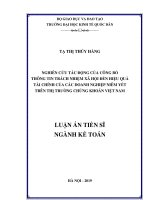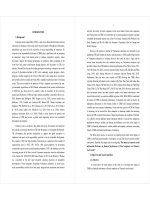Nghiên cứu tác động của những tài liệu dạy học do giáo viên tự thiết kế đến quá trình dạy tiếng Anh cho học sinh lớp 7 ở trường THCS Trần Phú, Hải Phòng
Bạn đang xem bản rút gọn của tài liệu. Xem và tải ngay bản đầy đủ của tài liệu tại đây (1.54 MB, 54 trang )
VIETNAM NATIONAL UNIVERSITY, HANOI
UNIVERSITY OF LANGUAGES AND INTERNATIONAL STUDIES
***
NGUYỄN THỊ VÂN MAI
The impact of teacher-generated materials on English
language teaching for the 7th grade students
in Tran Phu junior High School, Hai Phong
(Nghiên cứu tác động của những tài liệu dạy học do giáo viên tự thiết kế đến quá trình
dạy tiếng Anh cho học sinh lớp 7 ở trường THCS Trần Phú, Hải Phòng)
M.A Thesis Linguistics
Code : 60 14 10
HANOI - 2010
TABLE OF CONTENTS
DECLARATION
ACKNOWLEDGEMENTS
ABSTRACT
LIST OF TABLES AND FIGURES
LIST OF ABBREVIATIONS
PART A: INTRODUCTION
1. Rationales
2. Objectives of the study
3. Research questions
4. Methods of the study
5. Scope and significance of the study
6. Design of the study
PART B: DEVELOPMENT
Chapter 1: LITERATURE REVIEW
1.1. Theoretical background related to
1.1.1. Definitions of teacher-generated materials
1.1.2. Types of teacher-generated materials
1.1.3. The role of teacher-generated materials in English language teaching
1.1.4. How teacher-generated materials have been used in English language
teaching
1.2. The reasons teachers of English may choose to design their own materials
1.2.1. The advantages of teacher-generated materials
1.2.1.1. Save money
1.2.1.2. Recycle
1.2.1.3. Student focused
1.2.1.4. Match materials to curriculum
1.2.1.5. Differentiate instruction
i
ii
iii
iv
v
Page
1
1
2
2
2
3
3
4
4
4
4
4
5
6
7
7
8
8
8
8
9
1.2.1.6. Add in-depth information
1.2.2. The disadvantages of teacher-generated materials
1.2.2.1. Organization
1.2.2.2. Quality
1.2.2.3. Time
1.3. Factors to consider when designing materials
1.3.1. Learners
1.3.2. The curriculum and the context
1.3.3. The resources and the facilities
1.3.4. Personal confidence and competence
1.3.5. Copyright compliance
1.3.6. Time
Chapter 2: METHODOLOGY
2.1. Subjects and the context of the study
2.1.1. The subjects
2.1.2. The context
2.2. Data collection instruments
Chapter 3: DATA ANALYSIS AND DISCUSSION
3.1. Findings from the questionnaire
3.1.1. Students’ interest in English language learning
3.1.2. Students’ expectation of English language learning in their class
3.1.3. The frequency of the use of teacher-generated materials in English
lessons
3.1.4. The impacts of teacher-generated materials on English language
teaching and learning
3.2. Findings from the interview with teachers
3.2.1. The purposes of the English language teachers when using their own
materials
3.2.2. Ways of applying teacher-generated materials to daily lessons
3.2.3. Effectiveness of applying teacher-generated materials to daily lessons
3.3. Discussion of the findings
9
10
10
10
11
11
11
12
13
14
14
15
16
16
16
16
19
21
21
22
23
24
24
27
27
28
28
29
Chapter 4: SOME GUIDELINES FOR DESIGNING EFFECTIVE
MATERIALS FOR ENGLISH LANGUAGE TEACHING
4.1. Teacher-generated materials should be contextualized
4.2. Teacher-generated materials should stimulate interaction and be
generative in terms of language
4.3. Teacher-generated materials should encourage learners to develop
learning skills and strategies
4.4. Teacher-generated materials should allow for a focus on form as well as
function
4.5. Teacher-generated materials should offer opportunities for integrated
language use
4.6. Teacher-generated materials should be authentic
4.7. Teacher-generated materials should link to each other to develop a
progression of skills, understandings and language items
4.8. Teacher-generated materials should be attractive
4.9. Teacher-generated material should have appropriate instructions
4.10. Teacher-generated materials should be flexible
PART C: CONCLUSION
1. Conclusion
2. Limitations of the study
3. Suggestion for further study
Bibliography
APPENDICES
Appendix 1: Questionnaire (for students)
Appendix 2: Interview (for teachers)
Appendix 3: Summary of the interviews
30
30
31
32
33
33
34
35
35
36
36
38
38
38
39
40
I
I
V
VI
1
PART A: INTRODUCTION
1. Rationales
Over the years, English Language Teaching (ELT) has become more and more necessary
in Vietnam supplying learners (Ls) with an effective tool to integrate to the world.
Worker with high English proficiency are extremely required in many fields such as
politics, science, technology, economics, and tourism etc. Students (Ss) who become
fluent in English can have the opportunity to contribute to the development of their
country. Therefore, there is a great need to learn English both in formal institutions and in
community courses.
Nowadays, researchers claim that ELT in junior high schools contains a lot of challenges,
for example: large class, unequal qualifications among teachers (Ts), unequal levels
among Ss, lack of effective supplementary materials This fact was described by Joanna
Baker and Heather Westrup: “Many teachers have few resources, perhaps only a
blackboard and a few books. The school may not have technical resources such as tape
recorders, radios, television sets, video players or computers” (2002:3)
In Hai Phong, at Tran Phu Junior High School (JHS), day by day, Ts and Ss have to cope
with all these challenges at once which has unfavorable influence on English language
teaching and learning. Within them, lack of effective supplementary materials is the
hottest problem, has limited the result of English language learning (ELL) and the quality
of ELT. Designing supplementary materials is easier said than done especially in a JHS.
In theory, there has not been any research on this field with JHS teaching and learning
situation. In teaching practice, Ts of English have not paid serious attention to designing
supplementary materials as well as to using them in the right way.
All the reasons above have driven the researcher to the study thesis, named “The Impact
of Teacher-generated Materials on English Language Teaching for the 7
th
grade
Students in Tran Phu Junior High School, Hai Phong”.
2
2. Objectives of the study
The study aims to fulfill two objectives as follows:
(1) to investigate the impacts of teacher-generated materials on ELT for the 7
th
grade Ss in Tran Phu JHS, Hai Phong.
(2) to suggest some guidelines for designing effective materials for ELT.
3. Research questions
The study is carried out to find the answers to the following research questions:
(1) What value is teacher-generated materials to the ELT for the 7
th
grade
students in Tran Phu JHS, Hai Phong?
(2) How can Ts of English in JHS design effective materials for ELT?
4. Methods of the study
In order to reach the goals mentioned above, the study is implemented in the most
common procedure with the use of both quantitative and qualitative methods as follows:
- Reading relating books and articles from various sources (university library, Internet,
private library…) to collect useful information for the study.
- Consulting the supervisor and lectures of the Postgraduate Department and discussing
with colleagues to get guidance and insightful ideas in the field of the research.
- Administering a questionnaire to 107 the 7
th
grade Ss at Tran Phu JHS, Hai Phong.
- Interviewing 4 Ts of English (at different level of ability and at different age) at Tran
Phu JHS, Hai Phong.
- Analyzing and interpreting data and responses.
5. Scope and significance of the study
It is said that teacher-generated materials may impact on the efficiency of teaching and
learning of all grades in JHS. In this thesis, however, the researcher do not have an
ambition to take them all into consideration but only make an investigation in a small
scale into the teacher-generated materials applied by the Ts of English at Tran Phu Junior
3
High School for the 7
th
grade Ss and to give some guidelines for a better design and usage
of them to satisfy the Ss in their learning. The study is conducted with 107 the 7
th
Ss and
4 Ts of English at Tran Phu Junior High School, Hai Phong.
The research is carried out with the hope that Ts of English in particular and language
teacher in general may be fully aware of the role of teacher-generated materials to freshen
the lessons and to meet the Ss‟ demand in ELT. Moreover, findings of the study are
thought to be favorable in some way to the researcher and other Ts of English to design
effective supplementary materials that help Ts take advantages of teacher-generated
materials and meet their Ss‟ needs.
6. Design of the study
Part A – Introduction: provides rationales, aims of the study, research questions, scope
and significance of the study and design of the study.
Part B – Development: consists of three main parts
Chapter 1: Literature review on theoretical background of teacher-generated materials,
the reasons for Ts of English may choose to design their own materials, the factors to
consider when designing materials.
Chapter 2: Methodology introduces subjects and context of the study, data collection
instruments.
Chapter 3: Data analysis and discussion.
Chapter 4: Some guidelines for designing effective materials for ELT
Part C – Conclusion: presents conclusion, implications for teaching, limitation and
suggestions for further studies.
4
PART B: DEVELOPMENT
Chapter 1: LITERATURE REVIEW
1.1. Theoretical background of teacher-generated materials
1.1.1. Definitions of teacher-generated materials
In Cambridge Advanced Learner‟s Dictionary (third edition), the verb “generate” is
defined as “to create” while Webster‟s New Dictionary (1997) defines it as “to produce”.
In this thesis, the term “teacher-generated materials” is used for a particular type of
materials which are found, selected, evaluated and produced by Ts to use in their own
teaching context.
1.1.2. Types of teacher-generated materials
In this thesis, teacher-generated materials “include anything which can be used to
facilitate the learning of a language. They can be linguistic, visual, auditory or
kinaesthetic, and they can be presented in print, through live performance or display, or
on cassette, CD-ROM, DVD or the internet” (Tomlinson, 2001:66). They can be
instructional, experiential, elicitative or exploratory, in that they can inform Ls about the
language, they can provide experience of the language in use, they can stimulate
language use or they can help Ls to make discoveries about the language for themselves.
Designing and using resources to generate materials can be time consuming. Joanna
Baker and Heather Westrup (2002:157) brought out easily found resources as the relief
for busy Ts.
5
1.1.3. The role of teacher-generated materials in ELT
Nowadays, Ts are faced up with many challenges. There are Ss of all types and each one
of them expects something from the teacher. Keeping this in mind, Ts ought to see the
need for material design and material elaboration in order to meet such expectations.
Nunan (1988) reports that a survey of several hundred teachers in a large-scale English as
Second Language (ESL) progamme for adult migrants (Eltis and Low, 1985) found that
73 percent of the Ts “regularly used materials produced by themselves” and 50 percent
claimed not to use commercially-produced materials at all (Nunan, 1988:98). We might
infer that the 50 percent were so unhappy with commercially-available materials that they
felt driven to prepare their own and that the other 27 percent who regularly designed their
own materials felt that it was desirable to supplement the commercial material they were
using.
6
Similarly, Block (1991) claims that teacher-prepared materials are likely to be more up-
to-date and more relevant to Ss‟ needs and interests than equivalent course book
materials. For example, in order to provide a context for Ss to practice talking about what
they did the previous weekend, he suggests that a teacher might record his or her
colleagues taking about what they did. Such a recording, he notes, also has the attraction
that, like other specially prepared materials, it has a “personal touch” that Ss recognize
and appreciate.
Though Ls may still have a preference for a book over handouts, the increasing
availability of computer packages which enable Ts to design professional-looking
materials and the possibility in more technologically developed settings of incorporating
materials from the Internet can make teacher-generated materials an attractive (at least
occasional) supplement to the course books.
In general, teacher-generated materials play a necessary role in ELT, however, the
question of how to use them effectively is still in conflict and will be discussed later in
this study.
1.1.4. How teacher-generated materials have been used in ELT
Using teacher-generated materials in English as Foreign Language (EFL) classroom has
involved a large number of Ts in ELT, which has discussed in recent years.
Not everyone would agree that Ts should design their own materials. Block (1991), who
is in no doubt that they should, prefaces his arguments for what he calls DIY (do-it-
yourself) materials design by reviewing the papers by Allwright (1981) and O‟Neill
(1982) discusses in Chapter 1. Despite their contrasting positions on course books, both
Allwright and O‟Neill seem to agree that classroom Ts are not best equipped to write
materials. Allwright puts this explicitly: “the expertise required of materials writers is
importantly different from that required of classroom teachers” (p.6). Johnson (1972:1)
implies a similar view: “Teachers choose and use instructional materials because they can
not (and ought not) prepare all the materials they need”. Behind this view seems to lie the
assumption that materials are best prepared by professionals (i.e. knowledgeable and
experiences writers) and by publishing houses which can ensure a high level of
production (Sheldon, 1988). Maybe because of this unsympathetic view, Ts, especially in
junior high schools, tends to be afraid to design their own materials despite the need of
7
their teaching context. They would rather accept boring and ineffective lessons than be
laughed or criticized.
Some other Ts, it seems, have their own view. Block‟s (1991) argument that Ts should
prepare their own materials derives in part from his dissatisfaction with published
materials. The decision to supplement the course book may also be prompted by affective
considerations. Experienced Ts know that walking into class and saying: “Hello. Open
your books at page …” is not the best way to capture the attention of a group of learners,
and many use “warm-up” activities for this reason. They also know that there are other
points in a lesson (and there are not always predictable) or a certain time in the week
when learners just need something a little different. Maley (1998:281), probably thinking
of dreary days in Britain, refers to this as “the wet Friday afternoon affect”. This is the
time when learners are tired or apathetic or having difficulty, a time when learning needs
to be made lighter, more fun – through a game, a song, a video … A few of these Ts have
redundant self-confidence to work as materials designer but lack of experience to create
high quality materials or to use those ones in the best way for their Ss. It leads to
ineffective lessons, which are not really helpful for Ss to get and for Ts to transmit
knowledge. In some cases, the time and the content of the lessons are under the bad
influence of this inadequacy.
Indeed, when we think of how to use teacher-generated materials effectively, it is
necessary for us to deal with the reasons for Ts of English may choose to design their
own materials.
1.2. The reasons teachers of English may choose to design their own
materials
Discussions about the advantages and disadvantages of teacher-generated materials help
clarify the reasons for Ts of English may choose to design their own materials. They
often focus on a comparison with using text or course books. Instead of attending to
course books, the thesis has turned the attention to teacher-generated materials and find
that the disadvantages of the course books are able to become the advantages of teacher-
generated materials.
8
1.2.1. The advantages of teacher-generated materials
Teacher-generated materials are developed and produced by teaching professionals for
their own Ss. These are different from materials created for educators because they are
generated to fit the needs of the Ss in the classroom. Imagination and some good arts and
crafts skills are needed to generate materials for the classroom. Springboard off pre-made
materials or develop a new concept. Either way, there are several benefits of teacher-
generated materials.
1.2.1.1. Save Money
Materials purchased at education stores are expensive. Create the same materials for less
money by visiting a few hobby stores. For example, instead of buying a pre-assembled
puppet-making kit, go to the store and buy the different parts needed and combine them
in a plastic bag. Share ideas with other Ts to help them save, too (Joanna Baker and
Heather Westrup, 2002).
1.2.1.2. Recycle
Use materials around house or classroom. Challenge the students to bring in cans for an
art project. Give parents another place to bring old or used items: classroom. Create a list
of items needed and distribute it to the parents. Materials created with recycled materials
reduce waste immensely (Joanna Baker and Heather Westrup, 2002).
1.2.1.3. Student Focused
Teacher-generated materials can be designed with the specific needs of children in the
classroom in mind, which ensures that their interests and developmental needs are
incorporated into the classroom material. Custom materials of this nature keep Ss
engaged in activities and help them learn necessary skills. Thus, Ts will be creating
learning objects, the learners will be doing something with the materials and receiving feedback
about their performance and this feedback is an effective way to reinforce what you want the
students to learn (Lewis, 2003).
9
Ts work hard to put together lesson plans that are exciting and educational. However,
sometimes schools do not have the funding to provide all the supplies and materials that
Ts need in order to plan the most effective lessons. For this reason, there are many
benefits to Ts generating their own materials.
1.2.1.4. Match Materials to Curriculum
Sometimes the teaching materials provided by the school district will not be as current as
possible. One benefit of creating and putting together Ts‟ own materials and teaching
supplements is that Ts can pick and choose relevant materials to go along with the
lessons Ts are teaching. Ts can create specific activities that are appropriate for particular
groups of Ss. Not only will this make teaching job easier and more fluid, but the Ss will
get a more well-rounded education (Dewey,1916).
1.2.1.5. Differentiate Instruction
Ss learn in a variety of different ways. School districts may not have all the resources
available to maximize each student's learning potential. When Ts create materials to use
in the classroom, they can modify lessons and differentiate instruction by incorporating
technology. For example, a teacher may create visual presentations, provide audio and
video supplements and even incorporate music to engage students with a variety of
learning styles (Laurence-Brown, 2004).
1.2.1.6. Add In-Depth Information
When a school district purchases materials, they may select only the materials needed to
meet the core curriculum. If Ss are more advanced, or require more in-depth learning, Ts
may feel as though they have nothing more to provide them. When Ts create their own
teaching materials, they can make their curriculum more detailed and in-depth to allow Ss
who excel to learn more information about the topic they are teaching (Zieba-Warcholak,
2003).
In conclusion, the advantages of teacher-generated materials can be summed up in the
idea that they avoid the „one-size-fits-all‟ approach of most commercial materials.
10
1.2.2. The disadvantages of teacher-generated materials
There is a number of potential pitfalls for Ts who would be materials designers. These
can be considered under three headings.
1.2.2.1. Organization
Course books are usually organized around an identifiable principle and follow a
discernible pattern throughout. While this can be rather dull and boring (or „unrelenting‟)
it does provide both Ts and Ss with some security and a “coherent body of work to
remember and revise from” (Harmer, 2001:7). In contrast, teacher-generated materials
may lack overall coherence and a clear progression. Without some overall organizing
principle, materials may be piecemeal and can result in poorly focused activities lacking
clear direction. This is frustrating and confusing for Ls who may not be able to see how
their English is developing.
A further aspect of organization relates to the physical organization and storage of
materials. Without a clearly thought through and well-organized system, teacher-
generated materials may be difficult to locate for ongoing use, or may end up damaged or
with parts missing.
1.2.2.2. Quality
Possibly the most common criticism leveled against teacher-generated materials is to do
with their quality. At the surface level, teacher-generated materials may “seem ragged
and unprofessional next to those produced by professionals.” (Block, 1991:212, emphasis
in original). They may contain errors, be poorly constructed, lack clarity in layout and
print and lack durability. Harmer probably speaks for many when he says, “If the
alternative is a collection of scruffy photocopies, give me a well-produced course book
any time.” (2001:7).
In addition, a lack of experience and understanding on the part of the teacher may result
in important elements being left out or inadequately covered. Teacher-generated
materials may be produced to take advantage of authentic text. However, if not guided by
clear criteria and some experience, Ts may take inconsistent or poor choices of texts.
Besides, they can become outdated easily, e.g. news stories, articles.
11
A further problem may be a lack of clear instructions about how to make effective use of
the materials – particularly instructions designed for Ss.
1.2.2.3. Time
Yet another disadvantage of teacher-generated materials, and perhaps the key factor
inhibiting many Ts from producing their own teaching materials, is time. Almost Ts in
JHS (graduated from college) have not professionally educated to design and using
materials in the most effective way so special preparation is necessary and it can be time
consuming. “Any teachers in any environment can be pressed for time” (Bruce Marsland,
1998:1)
However, passionately one may believe in the advantages of teacher-generated materials,
the reality is that for many Ts, it is simply not viable – at least not all the time.
1.3. Factors to consider when designing materials
1.3.1. Learners
The first and most important factor to be considered is the Ls. If the point of teacher-
generated materials is relevance, interest, motivation and meeting specific individual
needs, then clearly Ts must ensure they know their Ls well. Any consideration of syllabus
or materials design must begin with a needs analysis. This should reveal learning needs
with regard to English language skills in listening, speaking, reading, writing, vocabulary
knowledge and grammar as well as individual student‟s learning preferences. It is not just
learning needs that are relevant to the teacher as materials designer, however. Equally
important is knowledge about students‟ experiences (life and educational), their first
language and levels of literacy in it, their aspirations, their interests and their purposes for
learning English.
The following summary of the learner factors that need to be considered in materials
design draws on Daoud and Celce-Murcia (1979), Matthews (1991), Harmer (1991),
McDonough and Shaw (1993) and Cunningsworth (1995)
1. age range
12
2. proficiency level in the target language (and homogeneity within the learner
group)
3. first language (all the same?)
4. academic and educational level
5. socio-cultural background
6. occupation (if relevant)
7. reasons for studying the target language (if applicable)
8. attitudes to learning (including attitudes to the language, its speakers, the
teacher, the institution)
9. previous language-learning experience (of the target language, its speakers,
other languages)
10. language-learning aptitude
11. general expectations (of the course/ textbook/ teacher/ own role)
12. specific wants
13. preferred learning styles
14. sex distribution (single sex? If mixed, what proportion of M/ F)
15. interests (insofar as these are generalisable)
In short, teacher-generated materials have to meet the same criteria as course book
materials, but these are likely to be more strictly applied because Ts know their own Ss
and will be able to „tune‟ the materials to suit their level, their aptitude, their interests,
their needs, and personalize it so that it seems even more meaningful.
1.3.2. The curriculum and the context
Discussing the curriculum, the researcher does need to pay further attention to the social
context in which it is created. Curriculum for Catherine Cornbleth (1990) is what
actually happens in classrooms, that is, “an ongoing social process comprised of the
interactions of students, teachers, knowledge and milieu” (p5). In contrast, Stenhouse
defines curriculum as the attempt to describe what happens in classrooms rather than
what actually occurs. Cornbleth further contends that curriculum as practice cannot be
understood adequately or changed substantially without attention to its setting or context.
Curriculum is contextually shaped.
13
The curriculum and the context are variables that will significantly impact on decisions
about teaching materials. Many Ts are bound by a mandated curriculum defining the
content, skills and values to be taught. Whether imposed at school or state level, a
curriculum, it is the teacher‟s responsibility to ensure that the goals and objectives of the
overarching curriculum are kept close at hand when designing materials (Nunan, 1988).
As noted earlier, the context in which the teaching and learning occurs will impact on the
types of materials that may need to be designed. For example, primary-level Ss, with
weak speaking and listening skills, may require materials that facilitate interaction about
subject content instead of developing cognitive academic language proficiency. However,
advanced-level Ss may need teaching materials that focus on complex tasks that require
clever reaction and combination of skills to solve.
1.3.3. The resources and the facilities
Although the government mandates a “highly qualified teacher” for every classroom, many
districts and schools still face the challenge of recruiting and retaining these professionals
to work under inadequate physical working conditions with grossly inadequate resources to
support their teaching efforts. The current national budget for school facilities
improvement and construction is greater than at any point in history. Due to the expanding
student population and the age of many school buildings, overall spending on facilities is
expected to increase, regardless of economic fluctuations.
There is a growing body of research confirming that the quality of facilities contributes
directly to teacher turnover rates and student performance. A study by Anthony S. Bryk on
the Carnegie Foundation for the Advancement of Teaching (1998) found that student
attitudes about education directly reflect their learning environment, and various other
studies have shown that clean air, good light, and a quiet, comfortable, and safe learning
environment are essential for academic achievement. As a condition under direct control of
the school district and state, the physical building setting of a school and its related
resources should be considered as much more than merely an institutional backdrop. They
should be considered as a potential opportunity to significantly improve teacher working
conditions, student learning conditions and student achievement.
14
1.3.4. Personal confidence and competence
Personal confidence and competence are factors that will determine an individual
teacher‟s willingness to embark on materials development. This will be influenced by the
teacher‟s level of teaching experience and his or her perceived creativity or artistic skills
and overall understanding of the principles of materials design and production. In reality,
most Ts undertake materials design to modify, adapt or supplement a course book, rather
than starting from scratch, and this is probably the most realistic option for most Ts.
Decisions available to Ts include the following (adapted from Harmer, 2001 and Lamie,
1999):
1. Add activities to those already suggested.
2. Leave out activities that do not meet your learners‟ needs.
3. Replace or adapt activities or materials with:
- supplementary materials from other commercial texts
- authentic materials (newspapers, radio reports, films etc.)
- teacher-created supplementary materials.
4. Change the organizational structure of the activities, for example, pairs, small
groups or whole class.
Modern technology provides Ts with access to tools that enable professional results in
materials production. Computers with Clipart, Internet access and digital pictures offer
unprecedented means for publishing high quality teaching materials.
1.3.5. Copyright compliance
Back in November, the New York Times ran an article about the growing number of
teachers who sell their lesson plans and other curriculum materials through online portals
like Teachers Pay Teachers (Winnie Hu, Selling Lesson Plans Online, Teachers Raise
Cash and Questions, Nov. 15, 2009). Obviously, teacher-made materials have been
considered as goods so Ts have to pay more attention to copyright compliance in
designing materials.
15
Because teacher-made materials are the product of Ts‟ brainwork, they tends to protect it
for themselves or to share in a small scope under their supervision and permission. For
use them in the classroom, Ts need to be aware of the restrictions that copyright laws
place on the copying of authentic materials, published materials and materials
downloaded from the Internet. This is particularly important when creating course
materials that will be used by a large number of classes over time. Copyright law has
implications when creating materials that include excerpts from published works. An
example of this would be creating a worksheet that uses a picture or exercise from a
commercial text, alongside teacher-created activities. While an idea cannot be copyright,
the expression of the idea can be and Ts need to be mindful of this. “If you do not
acknowledge the source you are, in effect, stealing material from another writer. This
stealing is called plagiarism and is a serious offense within the academic world”
(Princeton Writing Program, 1999)
1.3.6. Time
Time was discussed earlier as a disadvantage for Ts who wish to design their own
materials. It is thus, important to consider ways to make this aspect manageable.
Overcome the obsession of time consuming, arrange the housework and teaching job
reasonably, Ts are absolutely able to spend time on their own teaching materials. Block
(1991) suggests a number of ways in which Ts can lighten the load, including sharing
materials with other Ts, working in a team to take turns to design and produce materials,
and organizing central storage so materials are available to everyone.
Thus, this chapter has reviewed theoretical issues related to the thesis. In order to obtain
empirical knowledge of using teacher-generated materials in ELT to the 7
th
grade Ss in
Tran Phu JHS and to point out practical suggestions for teacher to design effective
materials, a study is conducted. Results of the study are presented in the next chapter.
16
Chapter 2: METHODOLOGY
2.1. Subjects and the context of the study
2.1.1. The subjects
In order to investigate into the impact of teacher-generated materials on ELT, the
researcher conducted a survey with two groups of subjects. They were 107 Ss in grade 7
and 4 Ts from Tran Phu JHS.
The questionnaires were distributed among both boys and girls Ss chosen incidentally
from gifted classes and normal ones at grade 7 to see their attitude towards the usage and
effectiveness of teacher-generated materials. They had learned English in JHS for two
years. Besides, during the time they were at primary school, English was brought to teach
in their syllabus as an optional subject.
Additionally, small-scaled unstructured interviews were carried out among 4 Ts, at
different age and level of ability, teaching English at Tran Phu JHS to see if they have
been using teacher-generated materials and how they have been designing these ones.
2.1.2. The context
The research is conducted at Tran Phu JHS which located at Le Chan District, Hai Phong.
This school has been being considered the gifted school for junior high students in Hai
Phong with over 50 years for training talented students. It always leads junior high
schools in Hai Phong area in prizes.
Ss here are chosen selectively mainly from some gifted primary schools in Hai Phong
such as Van To, Minh Khai, Dinh Tien Hoang so they seem to be better than ones in other
junior high schools. It is asserted by the number of prizes Tran Phu got in school-year
2009-2010 in comparison with some others in the same district.
17
Order
School name
The 1
st
prize
The 2
nd
prize
The 3
rd
prize
Consolation
prize
1
Tran Phu
32
48
54
65
2
Ngo Quyen
7
5
10
23
3
Truong Dinh
3
3
5
8
4
Vo Thi Sau
3
4
5
23
5
Ba Ngoc
2
5
5
13
6
Du Hang Kenh
1
3
1
8
7
To Hieu
6
8
10
8
Le Chan
2
3
8
9
Vinh Niem
1
3
8
10
Hoang Dieu
2
6
Table 1: The result of training talented students in Le Chan District
School-year 2009-2010
18
In general, Tran Phu Ss have better learning capacity, equipped with more comfortable
stationary and receiving more attentions than Ss in other schools. However, it is also the
main reason for their laziness, haughtiness as well as their reliance discouragement in
failures. Furthermore, the majority of Ss in this school have the need for learning the
lessons before class which leads to the artificial studying quality in the class and the
boring sensation of studying the same things too many times.
English group in Tran Phu JHS has fourteen Ts at different age, on different levels and
with different teaching experience, even some of them were not in a regular training as Ts
of English which causes the difficulties in designing general tests and the arguments in
marking crosswise. In addition, the conservativeness puts a hard barrier among them.
Male Female Regular In-service
0 1 26 < 5 1 0
0 6 32 < 10 1 5
0 7 45 > 10 2 5
Average
age
Teaching
experience
Educational form
Gender
Table 2: Ts of English in Tran Phu JHS
Taking the different ways of pronunciation as an example. Course books are written in
American English but almost Ts were educated in British English so they often
pronounce as their experience instead of the lessons with the attendance of another Ts or
school leaders. On the other hand, Ts can not get the standard tapes for the course books
from their school but from unreliable bookstores. Ts‟ incorrect pronunciation and bad-
qualified tapes have made Ss‟ pronunciation worse and worse.
There are 11 classes in grade 7, in which the smallest has 40 Ss and the biggest has 62 Ss.
This means that Ts and Ss can face the following challenges:
Ts can have difficulty keeping everyone‟s attention
Ss‟ motivation to learn English can be poor
Ss have difficulty hearing the teacher
Ts do not have enough opportunity to help weaker Ss
Attendance can be poor and irregular, leading to lack of continuity
This lack of continuity can cause extra work for Ts and confusion for Ss
Taking the register can be time-consuming
Ts can have too much marking to do
There are few resources to make learning interesting
19
(Joanna Baker and Heather Westrup, 2002)
The 7
th
grade Ss have three English lessons per week. Each unit lasts around 5 or 6
periods depending on the load of knowledge required. The National curriculum for JHS is
the textbook “Tiếng Anh 7”, published by Vietnam Education Publishing House. The
book “Tiếng Anh 7” consists of 16 units. Every four units, teacher spends a lesson
reviewing, a lesson testing and two lessons correcting and feeding back. Each unit
consists of 2 sections (A and B) with 5 activities as following:
- Introducing language target: includes Listen – Repeat/ Listen – Read/ Read.
- Examining comprehension: includes Ask – Answer/ Practice with a partner/ Match/
True – False.
- Practising: includes various exercises for listening, speaking, reading and writing skill
related to the topics of the unit.
- Language review: showed in Remember, helping Ss clearify the target language of the
unit.
- Practising grammar: showed in Language Focus, helping Ss organize grammar structure
and vocabulary in each unit through exercises.
2.2. Data collection instruments
This thesis used questionnaire and interviews as the main resources for data collection.
By using questionnaire, the researcher can obtain data quantitatively, which later on will
assist the study with persuasive figures concerning the investigated issues. It should be
noted that the writer had informal meetings with the Ss because they are not the Ss of the
researcher.
By using interview, the writer could have more in-depth information. The interview is
unstructured which still has to start with some kind of agenda, but it is loose one, a rough
checklist built around issues formulated in outline only. The direction of the interview
intentionally follows interviewee responses, with some of the characteristics of natural
conversation “The qualitative interviewer should arrive with a short list of issue-oriented
questions… The purpose for the most part is not to get simple yes or no answer but
descriptions of an episode, a linkage, an explanation. Formulating the questions and
anticipating probes that evoke good responses is a special art” (Stake, 1995:65). Before it,
20
the writer had prepared a set of questions. Furthermore, some possible follow-up
questions were also prepared (for the interview questions, refer to appendices). All the
interviews were recorded so that the writer could concentrate on observing interviewees‟
behavior without wasting time taking notes. Their facial expressions sometimes unveiled
more information than worlds could. These interviews were conducted individually in an
informal setting. Each interview took about 30 minutes, arranged at the interviewees‟
convenience. Enough time was spared for the interviewees to think of proper answers.
The steps of the research were arranged as follows:
(1) Piloting the questionnaire for students
(2) Delivering and collecting the questionnaire
(3) Conducting interviews with selected Ts
(4) Analyzing the collected data and discussing the finding
(5) Giving suggestions
21
Chapter 3: DATA ANALYSIS AND DISCUSSION
3.1. Finding from the questionnaire
The Ss‟ attitudes towards their ELL and ELT in JHS and teacher-generated materials are
collected by means of questionnaire. The result of the survey questionnaire has been
summarized in the following table.
Table 3: Result of the survey questionnaire
Options (%)
Statements
No
Very
little
Not much Much Very much
1. Would you like to learn
English?
0 5.6 37 35.2 22.2
2. Are you interested in ELL in
your class?
0 7.4 42.6 40.7 9.3
3. Does your ELL in your class
meet your demand?
0 22.22 40.74 33.33 3.71
5. Are they helpful to make the
lesson more interesting and
effective?
5.55 1.85 33.3 38.9 20.4
8. Would you like to have
more teacher-generated
materials in your English
lessons?
0 5.6 31.5 29.6 33.3
Options (%)
Statements
Never Rarely Sometimes Often Always
4. Does your teacher of
English often use materials
made by herself/ himself in
her/ his lessons?
0 11.1 25.9 38.9 24.1
7. Does your teacher of
English sometimes spend so
much time on the teacher-
generated materials that
cannnot focus on the main
part of the lesson?
35.2 48.1 12.9 1.9 1.9
Options (%)
Statements
Reading
skill
Writing
skill
Speaking
skill
Listening
skill
Vocabulary
Grammar
Structure
6. In which field, are teacher-
generated materials the most
helpful for your ELL?
6.9 13.9 11.1 8.3 16.7 43.1
Ss‟ responses are restructured and analyzed as follows.
